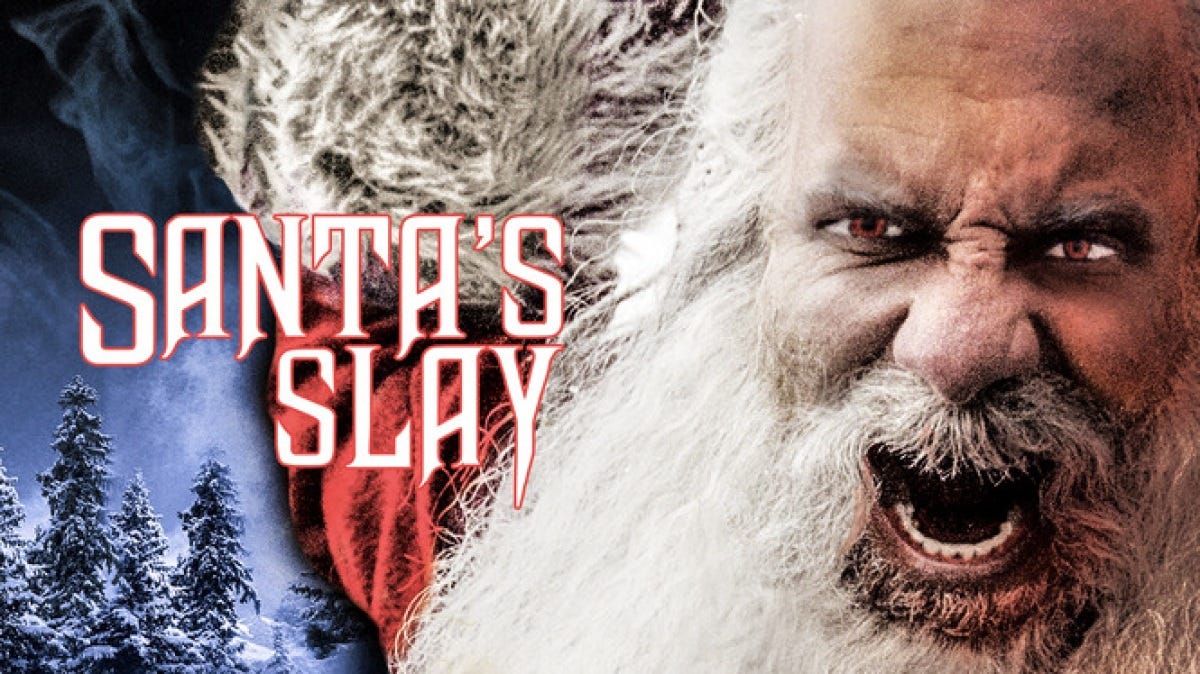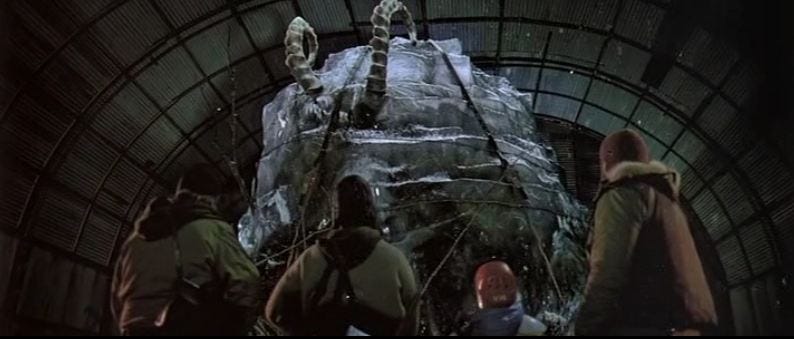The Twisted St. Nick of Horror
How horror films contort the iconic symbol of the holiday season
St. Nick, Kris Kringle, Father Christmas, Santa Claus – it doesn’t matter what you call him, you know who he is. He’s the jolly old man with a round belly and rosy cheeks, going down chimneys to eat cookies and drink milk. If you’re good, you get presents. If you’re naughty, you get coal. His legend is everywhere: you can find a version of Santa Claus in almost every county.
Ded Moroz in Russia, Pere Noel in France, Joulupukki in Finland–he is the personification of Christmas.
This fellow full of the holly-jolly spirit isn’t always depicted so great in our more modern tales, though. Within the horror genre, Santa is often the target of the storyteller’s manipulation, twisting him into a creature of great evil rather than a man of loving spirit.
Don’t Forget to Leave Out the Milk & Cookies
What happens when the real-life Santa Claus ends up being completely different than what we’ve been told? You get some real messed up Santas–way more messed up than your run-of-the-mill mall Santa.
For some reason, demonic entities turned jolly are a hot plotline in Christmas horror films. I could give reason to this, say that this is meant to represent the capitalistic ties to the holidays. I could say that a demonic Kris Kringle is meant to be a message about how the Santa Claus we all know and love came from a Coca-Cola marketing campaign, fueling the holiday to become a shell of its former self in focusing on consumerism. I could dive into how the love of money and materialism is the root of all evil, blah, blah, blah.
In reality, I don’t believe any of that, because the truth is that a demonic Santa is just plain cool.
I mean, really… We humans love the “what if?” situations. Marvel made an entire series out of it. It’s not a surprise that “what if Santa Claus was actually evil?” is a popular concept.
One film that has always stuck out to me was Santa’s Slay. It might be because I first saw it when I was a child, and you know, a demonic Santa sorta sticks with you at that age.
The film isn’t exactly Oscar-worthy, but it’s certainly an entertaining piece of media when looking back on it. Bill Goldberg is Santa, and any time wrestlers are part of a horror film, they’re usually pretty fun.
This demonic Santa in particular is actually the devil’s son. Cool, so that explains the demon stuff.
According to the lore of the film, Christmas was “The Day of Slaying” for Santa until A.D. 1005. It wasn’t until he lost a curling match with an angel that he was forced into becoming the commercialized Santa we know. Wait… curling match?
Yeah, best not to question the plotline of a comedy-horror film about a demonic Santa Claus played by Bill Goldberg.
Anyway, Santa was sentenced to delivering presents for 1,000 years. In the movie, that 1,000 years is finally up, and he’s set free to go back to his devilish ways.
The best part about this movie is that it’s practically the Christmas slasher film in terms of holiday-themed kills. He drowns people in eggnog, stabs people with tree toppers, even stuffs people with Christmas turkey. It’s full of fun and original kills.
In some regard, it acts as the buffer between your holiday films. After watching icons like National Lampoon’s Christmas Vacation and A Miracle on 34th Street, you can watch Santa’s Slay before diving into films like Black Christmas and Better Watch Out. It has the perfect amount of humor and gore to balance everything out, of course.
On the other hand, we have movies like Rare Exports: A Christmas Tale. While Bill Goldberg’s Santa is still dressed in the traditional holiday garb associated with the holiday mascot, this tale offers something a bit different… although, both try to bring forth some humor and silliness.
Certainly, I could dive into the fact that the elves in this aren’t little guys with pointy ears and funny shoes. Or I could talk about the fact that they kidnap children to feed Santa. But we aren’t focusing on that. We’re focusing on Santa.
In this film, Santa is depicted as a giant horned creature, imprisoned in an ice block. His elves, which are trying to dethaw the thing, bring kidnapped children for him to eat once he’s released from his prison.
While these films focus on a drastic change of traditional folklore, other horror movies take a different approach to a malicious Santa Claus.
It’s the Elves, Silly
Let’s go back in time.
The 1980s will always be known as the decade of the slasher. Freddy, Jason, and other icons were born from this era of horror–but did you know some classic Christmas horror films were too? See, the 80s was a time of abundance. When the decade of greed found success in the slasher genre, they hammered into it. Almost every other horror movie of this decade was a slasher, with competing production companies attempting to create the next big thing.
As such, we were given films like Silent Night, Deadly Night, a movie often brought up in conversation for Christmas horror. While this story follows the evil Santa trope, it brings a fresh perspective by adding more character and motive.
The main antagonist is Billy Chapman, who suffered severe trauma as a child after his parents were brutally murdered by a man in a Santa suit. His trauma continued in the orphanage, where Mother Superior beat the children who misbehaved. The story takes place when he’s 18-years-old, now working a normal job at a toy store.
Forced to play the store’s Santa for Christmas Eve, Billy attempts to play it cool. For the most part, he does okay, though keeps having flashbacks of his parents’ tragic death. It isn’t until he sees his co-workers in the back, where one is trying to sexually assault the other, that his mind completely slips.
The point of Silent Night, Deadly Night is trauma, more specifically being forced to face your trauma. Billy’s mental health was never addressed, despite going through horrible incidents at a young age, and thus faced the consequences of never receiving the proper help needed. In some regards, it can be taken as a commentary of how awful the foster and orphanage systems are in the United States, considering Billy was punished for everything rather than comforted.
Instead of the real Santa actually being a demon, it twists the evil Santa trope into something much more simple: a killer dressed as the big man in red.
Billy goes on a murder rampage, distracted by his crazed trauma. Each kill, he makes sure his victim knows they’ve been “naughty,” just as Mother Superior did when she punished the children in the orphanage. By the end of the film, when Billy attempts to finally murder Mother Superior, he’s shot by the police captain.
In his last moments, Billy says:
“You’re safe now. Santa Claus is gone.”
It’s sort of… a tragic end. Despite this film being another simple slasher, its use of childhood trauma creates a much more impactful story. Billy seems to snap out of his madness when he’s shot, realizing his pain will finally be set free. When he speaks of “Santa” being gone, he’s speaking of the trauma he went through. He knows that his death will release his suffering, and in turn, will keep everybody safe from his own psychosis.
Similarly, we have Christmas Evil, which follows a man dressed up in a Santa getup as well. Harry Stadling acts as our main character, working in a toy factory with belittling coworkers. Although this seems like the beginning of a classic revenge story, it’s more of a strange tale of identity crisis. Harry, for some odd reason, has taken it upon himself to become the next Santa.
It’s not just sleeping in a Santa costume. It’s not just decorating his apartment with Christmas decorations. He’s actively keeping tabs on neighborhood children, keeping track of who has been naughty or nice in his eyes. It’s certainly creepy, but not necessarily anything concerning in terms of psycho killer slasher films–he definitely needed the cops called on him though.
As he indulges himself in his own winter wonderland, he begins to go on a murder spree on the “naughty” adults, giving presents to the children.
Maybe we shouldn’t let just anybody dress up in a Santa costume.
Conclusion
The “Evil Santa” trope has been alive and well forever. For instance, we have folklore such as Krampus, which depicts an evil twin of the jolly old man. In horror, it only continues to grow stronger.
Happy holidays, dear friends.










